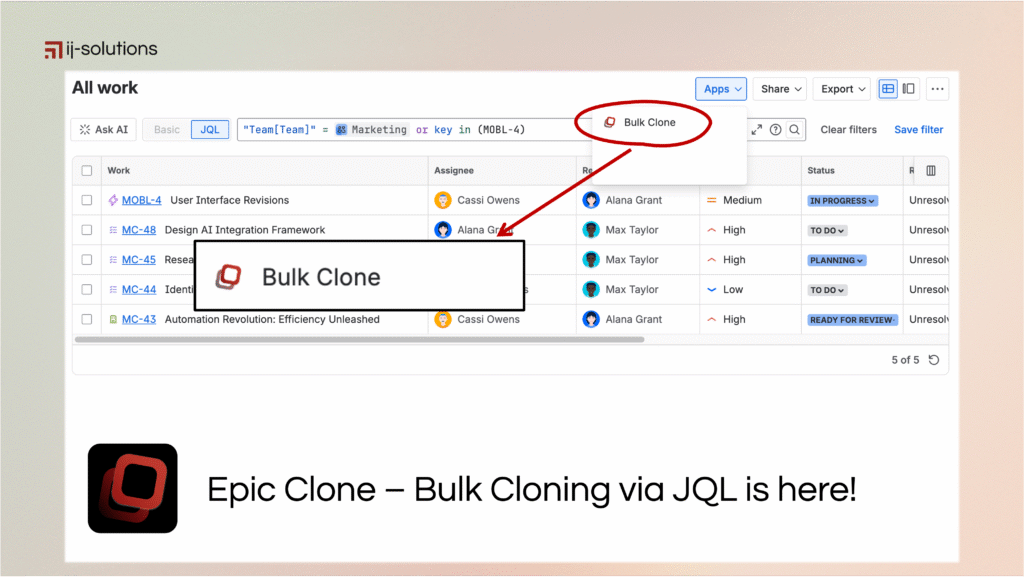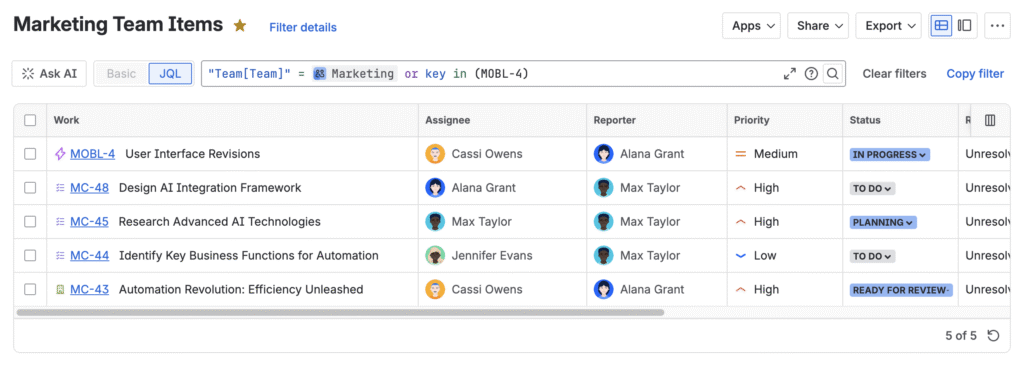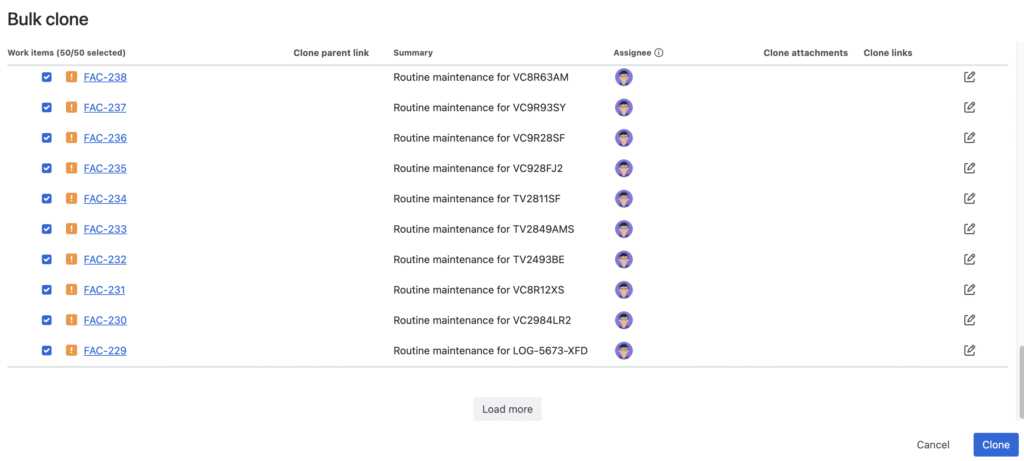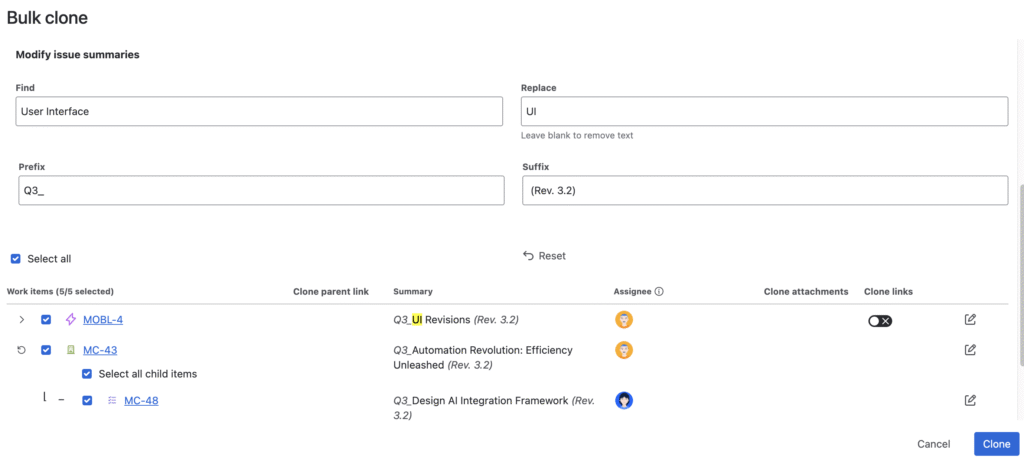At ij-solutions, we are committed to helping teams work smarter inside Jira. Today we’re excited to announce one of the most anticipated enhancements to our Epic Clone app: bulk cloning based on a JQL search. This new capability marks a significant milestone, enabling users to replicate large sets of Jira items faster, more accurately, and with fewer manual steps.
Why This Matters
Cloning multiple issues in Jira has long been a repetitive and time-consuming task—especially when you need to clone items matching specific criteria. With this update, teams can now harness the full power of JQL search to filter, select, and bulk clone items with precision. Whether you’re managing templates, repeating sprint structures, or replicating large backlogs, this is a genuine productivity boost.
This screenshot illustrates how easy it is to target the exact items you want to clone. With a single JQL query, teams can surface the full hierarchy of relevant issues and immediately prepare them for cloning.
A Closer Look at the New Feature
Before exploring the individual capabilities, it’s helpful to see how the new bulk cloning interface comes together.
The interface gives you a clear overview of the selected issues, all derived directly from your JQL results. From here, you can fine-tune how the cloned items behave, what is included, and how the hierarchy is preserved.
Feature Highlights: How Bulk Cloning via JQL Works
This update introduces several enhancements designed to make Jira item cloning more intuitive and efficient.
1. Clone Issues Directly from Any JQL Search
Run any JQL query—simple or complex—to instantly filter the items you want to clone. This may include epics, stories, sub-tasks, or mixed issue types.
2. Hierarchical Preview With Load-More Support
You can browse the full item structure, preview up to 50 items at a time, and load additional items for very large clone sets.
3. Cross-Space Cloning Options
Clone items within the same space or into a completely different one — a powerful capability for teams working across multiple Jira spaces.
4. Summary Modification Tools
Use find & replace, prefixes, and suffixes to instantly adapt item summaries to the new context.
5. Drag-and-Drop Hierarchy Adjustments
Easily reorder, re-parent, or restructure cloned items before executing the clone.
These improvements work together to ensure that even complex cloning operations stay manageable, visible, and adaptable.
Real-World Use Cases
To demonstrate the power of bulk cloning based on JQL, here are common scenarios where teams benefit most:
Repeatable Sprint or Release Structures
Teams using template epics or templated sprint setups can now clone entire structures through a simple JQL query.
Large-Scale Project Rollouts
Organizations can replicate full work item sets into multiple projects without doing that manually or conducting one-by-one clones of epics.
Backlog Replication Across Teams
Use a JQL query such as:
project = ABC AND labels = “campaign” AND issuetype = Story
…and instantly clone the whole campaign backlog into another teams space.
Parallel Work Branching
Teams that need a separate set of items for branching or testing can duplicate issues cleanly while maintaining structure.
This visual breakdown makes it clear how Epic Clone preserves the full hierarchy across all cloning operations.
Tips for Getting the Best Results
While the new cloning engine is designed to be intuitive, a few best practices can further improve your experience:
Craft precise JQL queries to ensure you’re cloning exactly the issues you intend.
Preview the full list using the load-more option when working with large datasets.
Use prefix/suffix modifiers to label cloned items for new sprints, versions, or projects.
Decide your linking strategy—whether to keep links to original items or create independent clones.
With these recommendations, you can make the most out of JQL-driven cloning and streamline your workflows even further.
How to Get Started
- Update Epic Clone to the latest version (only necessary if you are running on an outdated major version).
- Open the Item Navigator
- Enter your JQL search to define your clone set.
- Open Apps → Bulk Clone.
- Select the target space.
- Configure cloning settings (attachments, links, summary editing).
- Review the structure.
- Click Clone and let the app handle the rest.
Ready to Speed Up Your Jira Workflow?
The introduction of bulk cloning via JQL in Epic Clone is a major step forward for teams that manage structured, repeatable workflows. By combining powerful search filtering with flexible cloning options, Jira teams can now work faster, cleaner, and more consistently than ever before. Try Epic Clone free today to take advantage.







